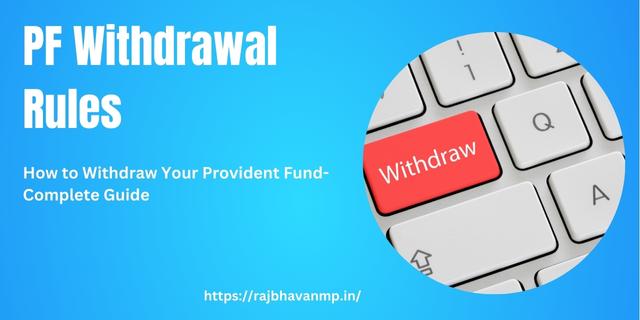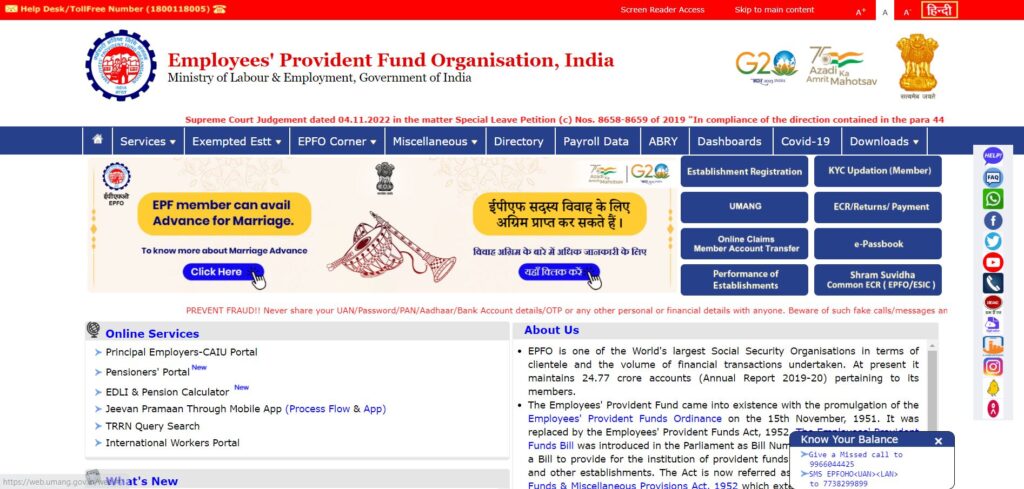PF Withdrawal Rules 2023 have changed recently and now the employees are eligible to withdraw up to 75% of their net EPF account balance or the amount that is worth up to rupees 3 months of the basic salary. The withdrawal amount is not refundable. The main goal of the EPF system that is created by the Indian government was to provide proper security to the Employees who are working in government or private institutes available in India. The people who are working in private companies do not have enough money that they can invest in their retirement plans so the EPF comes into play. 12% of the salary of the employee is donated towards their EPF account and then employers also donate 12%. You can check out the major information about the latest PF withdrawal rules 2023 from the article provided below.

Brief on Changes in PF Withdrawal Rules for 2023
The employees can check out the major information about the changes that has been observed in the PF withdrawal rules from the pointers given below:
- EPF funds cannot be withdrawn while employed, and can only be reclaimed after retirement.
- Partial withdrawals are allowed for emergencies such as medical expenses, home purchases, or education, with limitations based on the cause.
- If an employee loses their job due to death, layoff, or bankruptcy, they may be eligible to reclaim their EPF funds.
- Tax exemption on EPF funds is available only if the worker contributes for 5 consecutive years; a gap in contributions results in the EPF balance being taxed.
- Taxes are withheld on premature withdrawals, with a TDS rate of 10% if PAN is submitted; the entire EPF balance may be taxed if contributions are not made for 5 consecutive years.
- Approval from the employer is no longer required for EPF payments, which can be done instantly online if the individual’s Aadhaar and UAN are linked and verified by the firm
Also Read: EPF Claim Status
Eligibility Criteria
The eligibility criteria for PF withdrawal are as follows:
- Employment status: Only current or former employees who have contributed to the Employee Provident Fund (EPF) for a certain period are eligible to withdraw from their PF account. The minimum period of employment to be eligible for withdrawal is 5 years.
- Account balance: The amount that can be withdrawn depends on the account balance at the time of withdrawal. Employees can withdraw up to 75% of their total PF balance after one month of unemployment, while the remaining 25% can be transferred to another PF account.
- Time limit for withdrawal: There are specific time limits for different types of withdrawals. The full withdrawal is allowed only after the employee attains the age of 58. In the case of partial withdrawal, employees can withdraw only after completing 5 years of service, and they can make partial withdrawals for specific reasons. For advance withdrawals, the time limit is determined by the number of years of service.
Also Check: OROP Pension Table
Documentation Required
The following documents are required to fill out the PF withdrawal form to successfully get the PF in your account:
- The employer can provide the UAN (Universal Account Number), which is a necessary condition.
- The name as it appears on the EPF account must accompany the bank account information in writing.
- The provident fund holder must have a bank account since money cannot be transferred to a third party while the holder is still alive.
- The identity evidence and personal details, such as the father’s name and birthdate, should match exactly.
- When an employee leaves the company, the employer must notify EPFO (Employee Provident Fund Organization) of the details. Both the joining and departing dates must be specified in detail.
Types of PF Withdrawals
There are different types of withdrawals and the employees can check out the details of the withdrawals from the pointers given below:
- Full withdrawal: When an employee reaches retirement age, they can withdraw their entire accumulated balance from their PF account. This includes their own contribution, as well as the interest earned on it and the employer’s contribution. The full withdrawal is available only after the employee attains the age of 58.
- Partial withdrawal: An EPF account holder can make partial withdrawals from their PF account for specific purposes. Some of the eligible reasons for partial withdrawal include medical emergencies, education, marriage expenses, and house purchase or construction. The amount that can be withdrawn varies depending on the cause of withdrawal and the balance in the account.
- Advance withdrawal: EPF account holders can make an advance withdrawal if they face a financial crisis or an urgent need for funds. This type of withdrawal is allowed for a maximum of three times during the entire service period, and the withdrawal amount is limited to the basic salary and dearness allowance of the employee.
- Pension withdrawal: After attaining the age of 50 years, an employee can opt for pension withdrawal if they do not want to continue with the job. The employee will receive a monthly pension after withdrawing from the PF account. The pension amount is calculated based on the employee’s years of service and the balance in the account.
- Withdrawal after termination: An employee can withdraw the entire PF balance if they lose their job due to termination or resignation. The withdrawal can be made after two months of the last contribution. In this case, the withdrawal is subject to tax deduction at source (TDS) if the total balance exceeds Rs. 50,000
Also Read: SBI HRMS Portal
Step-by-Step Guide to Withdraw PF
The applicant must follow the following procedure in order to successfully apply for a PF withdrawal:
- If you haven’t activated your EPF account, you need to do so by visiting the EPFO official website

- Click on the Services tab followed by For Employees
- A new page will open on the screen
- Now, under the services tab, click on the Member UAN/Online Service (OCS/OTCP) option
- A new page will open on the screen
- Enter your details such as UAN, mobile number, and PF number to activate the account.
- After activation, log in to the EPFO portal using your UAN and password.
- Once logged in, click on the ‘Online Services’ tab and select ‘Claim (Form-31, 19 & 10C)’ from the drop-down menu.
- You will then be redirected to a new page where you will be required to enter details such as your bank account number, the reason for withdrawal, and the amount to be withdrawn.
- After filling in the required details, submit the application.
- The PF withdrawal application will be sent to your employer for verification. If the details provided by you match the records maintained by the employer, the application will be approved.
- In case of any discrepancies, the application will be rejected.
- After verification and approval, the funds will be transferred to your bank account linked to your EPF account.
- The transfer process usually takes around 5-10 business days, depending on your bank’s processing time.
- It is essential to note that taxes may apply on PF withdrawals if you have not completed 5 years of continuous service.
- If you withdraw your PF balance before 5 years, the amount will be taxed as per the income tax slab rate.
Contact Details
- Toll-Free Number: 1800-118-005
PF Withdrawal Rules 2023 Frequently Asked Questions (FAQs)
Under the new rules, PF account holders can withdraw up to 75% of their total PF or EPF account balance or an amount equal to three months’ basic pay and dearness allowance, whichever is less. There is no specific minimum withdrawal amount.
If you apply for PF withdrawal online, the EPFO is required to settle the claim within 3 working days from the date of application. However, if you apply offline, it may take up to 20 days for the claim to be settled.
No, you cannot withdraw your PF amount while you are still employed. However, you can withdraw a partial amount for certain purposes like medical emergencies, home purchase or construction, or higher education.
Yes, it is mandatory to link your Aadhaar with your PF account for online withdrawal. However, if you apply offline, you can submit other documents like PAN or bank account details.
Yes, if you withdraw your PF amount before completing 5 years of continuous service, the amount withdrawn will be taxable. If you withdraw after 5 years, the amount will be tax-free. However, if the total amount withdrawn in a financial year exceeds Rs. 50,000, TDS will be deducted.
